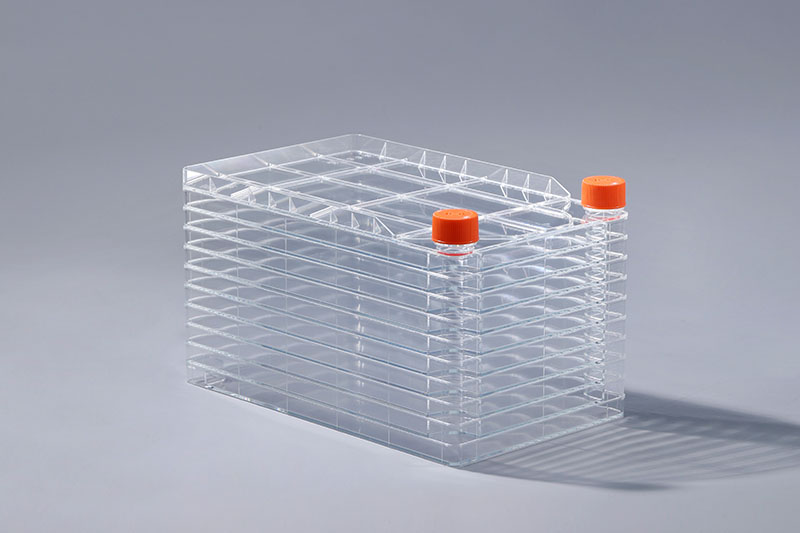হল সেল কালচার কনজিউমেবলের একটি মাল্টি-লেয়ার স্ট্রাকচার, প্রধানত ভিট্রো সেল কালচারে বড় আকারের জন্য ব্যবহৃত হয়। কোষের চাষ করার সময়, একটি নির্দিষ্ট পরিবেশের প্রয়োজন হয়, এবং গ্যাসের পরিবেশ এবং pH মান হল সবচেয়ে গুরুত্বপূর্ণ শর্তগুলির মধ্যে একটি। কোষের চাষ করার সময় কোষ কারখানা যে গ্যাস পরিবেশকে বোঝায় তা মূলত কার্বন ডাই অক্সাইড এবং অক্সিজেন. অক্সিজেন কোষের ট্রাইকারবক্সিলিক অ্যাসিড চক্রে অংশগ্রহণ করে কোষের বৃদ্ধি, বিস্তার এবং বিভিন্ন প্রয়োজনীয় উপাদানের সংশ্লেষণের জন্য শক্তি উৎপন্ন করে। কিছু কোষ হাইপোক্সিক অবস্থায় গ্লাইকোলাইসিসের মাধ্যমে শক্তি পেতে পারে, কিন্তু বেশিরভাগ কোষ হাইপোক্সিয়ার অধীনে বেঁচে থাকতে পারে না। অক্সিজেনের উত্তেজনা সাধারণত বায়ুমণ্ডলীয় অবস্থার সামান্য নিচে বজায় থাকে এবং যদি অক্সিজেনের আংশিক চাপ বায়ুমণ্ডলে অক্সিজেনের পরিমাণ অতিক্রম করে তবে কিছু কোষ ক্ষতিকারক হতে পারে। ওপেন কালচার (থালা বা কালচার বোতল লুজ-ক্যাপ কালচার বা কালচার প্লেট কালচার) ব্যবহার করার সময়, কোষগুলি সাধারণত 95% বায়ু এবং 5% কার্বন ডাই অক্সাইডের মিশ্র গ্যাস পরিবেশে স্থাপন করা হয়। cell factory
কার্বন ডাই অক্সাইড শুধুমাত্র বিপাক নয় কোষ, কিন্তু কোষ বৃদ্ধির জন্য একটি অপরিহার্য উপাদান, এবং সংস্কৃতি মাধ্যমের pH বজায় রাখার সাথে সম্পর্কিত। একটি বদ্ধ পরিবেশে কম কার্বন ডাই অক্সাইড ঘনত্বের ক্ষেত্রে, কোষগুলি সহজে বৃদ্ধি পায়; সাধারণত এটি 1% এর কম হতে পারে না, অন্যথায় কোষগুলি ক্ষতিগ্রস্ত হবে। যদি উন্মুক্ত সংস্কৃতি 5% কার্বন ডাই অক্সাইডযুক্ত গ্যাস পরিবেশে স্থাপন করা হয়, তাহলে এটি বাঞ্ছনীয়৷
অধিকাংশ কোষ pH 7.2~7.4-এ বৃদ্ধির জন্য উপযুক্ত, pH 6.8-এর চেয়ে কম বা pH 7.6-এর চেয়ে বেশি কোষের জন্য ক্ষতিকর, এবং এমনকি অধঃপতিত বা মারা যায়। পিএইচ মানের জন্য বিভিন্ন কোষের বিভিন্ন প্রয়োজনীয়তা রয়েছে। সাধারণত, প্রাথমিক সংস্কৃতি কোষগুলি অ্যাসিড সহনশীলতার তুলনায় ক্ষারীয় পিএইচ মান কম সহনশীল, এবং একটি অ্যাসিডিক পরিবেশ একটি ক্ষারীয় পরিবেশের তুলনায় কোষের বৃদ্ধির জন্য বেশি উপকারী। সংস্কৃতি পরিবেশের একটি ধ্রুবক pH মান বজায় রাখার জন্য, ফসফেটের মতো একটি বাফার যোগ করার একটি পদ্ধতি প্রায়শই ব্যবহার করা হয়। ক্ষেত্র কিন্তু এটি কোন ক্ষেত্রেই ব্যবহার করা হোক না কেন, কোষের সংস্কৃতির সময় গ্যাসের পরিবেশ এবং পিএইচ মান এখনও কোষের বৃদ্ধির জন্য একটি গুরুত্বপূর্ণ শর্ত।
Most cells are suitable for growth at pH 7.2~7.4, lower than pH 6.8 or higher than pH 7.6 are harmful to cells, and even degenerate or die. Different cells have different requirements for pH value. Generally, primary culture cells are less tolerant to alkaline pH value than acid tolerance, and an acidic environment is more beneficial to cell growth than an alkaline environment. In order to maintain a constant pH value of the culture environment, a method of adding a buffer such as phosphate to the medium is often used.
With the rapid development of the field of life science, cell factories are being applied to more fields. But no matter which field it is used in, the gas environment and pH value during cell culture are still one of the important conditions for cell growth.
The FAI climbed 5.9 percent year-on-year in the first 11 months of 2018, quickening from the 5.7-percent growth in Jan-Oct, the National Bureau of Statistics (NBS) said Friday in an online statement.
The key indicator of investment, dubbed a major growth driver, hit the bottom in August and has since started to rebound steadily.
In the face of emerging economic challenges home and abroad, China has stepped up efforts to stabilize investment, in particular rolling out measures to motivate private investors and channel funds into infrastructure.
Friday's data showed private investment, accounting for more than 60 percent of the total FAI, expanded by a brisk 8.7 percent.
NBS spokesperson Mao Shengyong said funds into weak economic links registered rapid increases as investment in environmental protection and agriculture jumped 42 percent and 12.5 percent respectively, much faster than the average.
In breakdown, investment in high-tech and equipment manufacturing remained vigorous with 16.1-percent and 11.6-percent increases respectively in the first 11 months. Infrastructure investment gained 3.7 percent, staying flat. Investment in property development rose 9.7 percent, also unchanged.
 English
English



















































